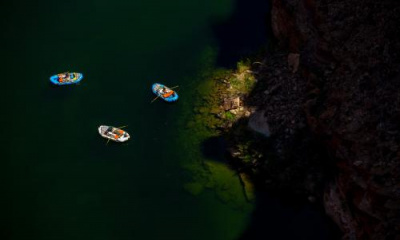SALT LAKE CITY — The Great Salt Lake is in a much better spot than it was this time a year ago, as it reached its current all-time low.
Its southern arm is back to just over 4,192 feet elevation after the ebbs and flows of the state's record snowpack, the irrigation season and summer evaporation, about 3½ feet above where it was last November, per U.S. Geological Survey data. Its northern arm is listed at 4,189.2 feet elevation, remaining well below the southern arm as a result of a berm that was raised to protect the southern arm's salinity levels.
But its current levels still pose "adverse effects" to neighboring communities, and the lake remains well below the minimum levels that are considered healthy, says Brian Steed, Utah's Great Salt Lake commissioner.
"While it was a great year, we have a long way to go to get back to historical averages," he said, speaking with Great Salt Lake Collaborative reporters on Wednesday. "That's something we're going to be working on over the next years to make sure we have sufficient water and that the lake gets back to more healthy ranges."
Steed is scheduled to meet with Gov. Spencer Cox at the end of the month, where he will present his strategic plan for the lake as outlined by the law that created the commissioner position earlier this year.
That's not the only report expected to be released ahead of Utah's next legislative session. The Great Salt Lake Strike Team, a mixture of researchers and experts from Utah State University, the University of Utah and state agencies, is also scheduled to release its next team report next month before releasing its second policy assessment in January. There are a pair of local and state symposiums this week where the topic is being discussed.
These reports will likely continue to shed more light on how much water is needed to get to the lake over a certain period of time and how it can be achieved. But Steed cautions that there likely won't be an overnight fix.
He and members of the Great Salt Lake Strike Team met with the Great Salt Lake Collaborative to discuss what is being considered as short-term, medium-term and long-term options over a span of about 20 years.
The strike team calculates that, depending on drought conditions, about 1.06 to 1.64 million acre-feet of water flows into the lake every year. It estimates that it would take about 1.1 to 1.7 million acre-feet of additional water annually to reach the optimal range of 4,198 feet elevation over the next five years, again depending on drought conditions.
It would take about 705,000 to 1.3 million acre-feet to reach the same goal in 10 years, or 531,000 to 1.1 million acre-feet to reach it in 20 years, according to the team's projections. It adds that the state can also reduce environmental impacts by setting its goal to 4,195 feet elevation first, which would require a little less additional water.
Any water above where the lake stands now is "progress in the right direction," Steed argued. However, based on these estimates, he believes it's more likely than not that the state will look at "longer-term targets" to get to 4,198 feet elevation.
"I do think that longer runway is probably more realistic than filling it immediately," he said. "It's a very high amount of water required in a very short time frame for that five-year window. ... The reality is that part of the problem is balancing this equation, water for people and water for the lake. We have to make sure it's sufficient for both needs."
What are the solutions being considered?
Steed added that it's going to take a "suite of alternatives" to get that additional water to the lake. The state has already implemented agriculture water optimization and temporary water lease programs, though those are still being finetuned to ensure water goes to the lake.
The state could look into split-season leases, which create a program to pay farmers to reduce their crop yields by one or two cuts and send any water downstream toward the lake, he said. Agriculture water use accounts for about two-thirds of the lake's diverted upstream water, according to the Utah Department of Natural Resources.
Other solutions include measures tied to mineral extrication on the lake, which accounts for nearly a 10th of the lake's water, and to how water is used as communities grow along the Wasatch Front and northern Utah, something that accounts for nearly a fifth of the water.
Candice Hasenyager, director of the Division of Water Resources, said there are ongoing efforts to meter secondary water and reduce grass turf to help reduce overconsumption in these areas.
"How we grow matters, and it sets our water use for decades to come," she said.
Steed says water could also be diverted to problematic dust spot areas as needed.
What about this winter?
The lake could also stand to benefit this winter as the legislative session plays out. The National Weather Service Climate Prediction Center's winter outlook lists most of the Great Salt Lake Basin as having a slightly higher probability of near-normal or potentially above-normal precipitation this season.
Experts agree that even an average winter can be beneficial for the Great Salt Lake. That's because last winter's precipitation mixed with rain over the spring, summer and fall greatly improved soil moisture, which means less water will be lost to the ground during the spring snowmelt.
Utah's reservoir capacity is also currently about 75% full, 21 percentage points above the median and 34 percentage points above levels recorded last season. This means that less snowmelt runoff will be needed to refill reservoirs.
"I think we're in better shape, certainly, than we were last year because the groundwater is fuller," says David Tarboton, director of USU's Utah Water Research Laboratory. "And also with the reservoirs full, not as much will be held back, so more might get to the lake."








